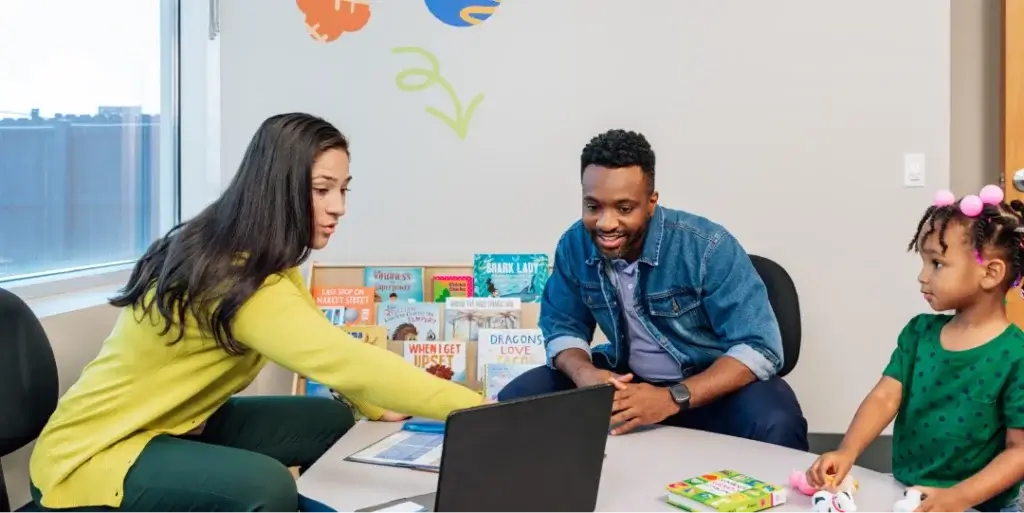Why Parent Involvement is Crucial to Autism Therapy
June 18, 2025
June 18, 2025

Your child means the world to you. When they experience challenges that could benefit from an evaluation or therapy, as children with autism spectrum disorder (ASD) do, it can be nerve-wracking to take those first steps to seek outside help. It may feel strange to send them somewhere new for therapy and question what goes on or whether they are receiving the best possible care.
With Hopebridge, you don’t have to wonder. We show you.
Whether your child attends center-based autism therapy at one of our locations, or a clinician comes to you for in-home therapy or Telehealth sessions, we want you on our team for everything we do. Your child means the world to us, too, and we can’t give them our best without you. This is why family guidance is a key piece of our service mix.
“Family Guidance is one of the most rewarding and important components of a child’s ABA programming. At Hopebridge, we focus on the entire family – how we can involve them, how we can empower them in their support of their child, and how we can do those things in a way that isn’t intimidating or difficult to execute,” said Hopebridge Clinical Trainer Meg Moore.
We understand that some families are initially skeptical about what to expect from their child’s therapy, but at Hopebridge, we strive for caregiver involvement. Won’t don’t just want it–we need it!
Here are six the reasons why family participation is so important:

Hopebridge designed a special family guidance curriculum that includes a series of modules to get caregivers and clinicians started with their sessions. Within these first few sessions, families can expect ABA therapy education and expectations, as well as assessments and activities to help behavior analysts gain a better understanding of the family’s values, needs and obstacles.
Then, using the knowledge gained from the initial conversations, BCBAs and caregivers work together to determine meaningful goals, before diving into practice sessions.
Just as Hopebridge approaches other areas of autism therapy, family guidance is individualized and will look different for each child.
For children who attend therapy at Hopebridge, training sessions can either take place at the center to work with them one-on-one, or they can occur via telehealth consults, which give clinicians the opportunity to watch families interact with their child in the home setting. Families utilizing in-home therapy usually also receive family guidance at home.
At a minimum, Hopebridge meets with parents or guardians for an hour a month, but it’s not uncommon to work with caregivers on a weekly or bi-weekly basis in smaller increments. We really want to connect with caregivers and are flexible according to their schedules and their child’s needs.
We meet the parents wherever they need to start.
“They are the experts of their children, and it is powerful to create a collaborative team between the family who knows the child best and the clinician who can help support and drive their hopes and desires through ABA therapy,” said Meg. “The children we work with don’t live in our centers, and by including families in their child’s treatment, it empowers them to continue making progress and supporting their child in the settings that truly matter to them outside of our centers.”
As family guidance progresses, BCBAs may use the time to teach caregivers the foundational concepts and how it relates to the skills they’re working on with their child. They explain what and how they’re teaching it, as well as show them exactly how it’s implemented.
A keep part of our family guidance curriculum includes building rapport with caregivers and any others in the household.
“Parents need pairing, too! We like to get to know a little about them so we can build a stronger connection. Some of this may seem trivial at first, but we work so closely with their kids that it’s important we show them care, too,” one of our BCBAs told us.
Goal-setting is frequently discussed during these sessions. Caregivers know their child better than anyone else, so they help guide the plan of care by sharing what is significant within their family. The BCBA may think certain targets are important – and they likely are – but if it’s not important to the family, there is no use making it a goal for the child.

We ask caregivers what is most important to them for their child and try to help them achieve it. Toilet training, communication and decreasing tantrums are common goals. We want to know what the families’ priorities are, too, so we can align with them. What’s important to them is important to us.
Some training sessions include reviewing the patient’s plan of care, functional behavior assessment results, or the results of other assessments. They can talk about the patient’s progress and goals. When Anne served as a practitioner, she liked to show parents their child’s progress by reviewing and interpreting her graphs together.
Family guidance can also be used to go through the behavior intervention plan to make sure parents are comfortable with everything, as well as have it generalized across environments.
We want their buy-in on this, so we work together on it and ask for permission in certain areas. For instance, if a child is known to run and elope, how do we attempt to prevent this behavior with antecedent strategies, and how do we react if the behavior occurs? Consistency is key, so we need their understanding, acceptance and support to follow it at home, too.
Behavior analysts can also use this time to teach parents how to interact and play with their child in skill-building ways. Then, we want them to take the skills they learn in the clinic and bring them home to practice with their child.
Do you want a voice in your child’s therapy?
Our team collaborates with you from the beginning. Many of our centers offer family orientation even before the child’s first day of therapy, which gives caregivers and their kids an insider look at what goes on during ABA, speech and/or occupational therapy. From there, we’ll work together to determine a family guidance schedule that works for you.
We want to work with you to help your family achieve your goals for your child’s autism services. To find out what family guidance can look like for you, fill out our online form to schedule a diagnostic evaluation or ABA evaluation through one of our Hopebridge locations across the country.
*Informed consent was obtained from the participants in this article. This information should not be captured and reused without express permission from Hopebridge, LLC. Testimonials are solicited as part of an open casting call process for testimonials from former client caregivers. Hopebridge does not permit clinical employees to solicit or use testimonials about therapeutic services received from current clients (Ethics Code for Behavior Analysts 5.07-5.08; BACB, 2020). Hopebridge does not provide any incentives, compensation, or renumeration for testimonials provided by a former client or client caregiver.
Autism Therapy
April 29, 2024
Autism Therapy Clinicians and Families Benefit from Grand Rounds at Hopebridge
Autism Therapy
January 13, 2020
New AAP Report States Early Intervention for Autism is Essential for Lifetime Development
Autism Therapy
January 24, 2022
What the Increased Prevalence of Autism in Children Means for Your Family
Autism Therapy
September 19, 2018
What Does a Day at Hopebridge Look Like for your Kiddo? - Ask Kim Video Series